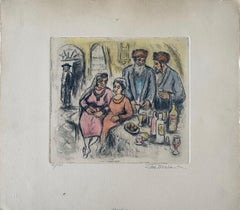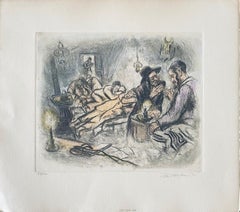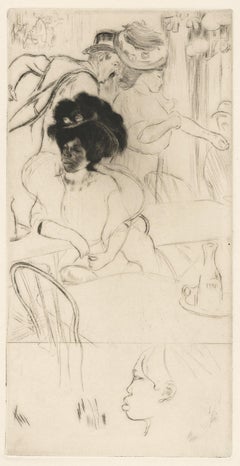Ira Moskowitz Interior Prints
to
2
Overall Width
to
Overall Height
to
2
130
108
79
34
32
2
2
1
1
2
Artist: Ira Moskowitz
Judaica interior scene etching with hand coloring
By Ira Moskowitz
Located in Surfside, FL
I believe the scene is of a wedding engagement. etching with extensive hand coloring (making it a unique original work of art)
Ira Moskowitz (1912-2001), descendant of a long rabbin...
Category
20th Century Post-Impressionist Ira Moskowitz Interior Prints
Materials
Lithograph
Judaica interior scene etching with hand coloring
By Ira Moskowitz
Located in Surfside, FL
Etching with extensive hand coloring (making it a unique original work of art)
Ira Moskowitz (1912-2001), descendant of a long rabbinical line, was born in Galicia Poland and went w...
Category
20th Century Post-Impressionist Ira Moskowitz Interior Prints
Materials
Etching
Related Items
Bow Street Office: Rowlandson Hand-colored Engraving from Microcosm of London
By Thomas Rowlandson
Located in Alamo, CA
An early 19th century print entitled "Bow Street Office", an illustration (Plate 11) from "The Microcosm of London", published in London in 1808 by R. Acker...
Category
Early 1800s Other Art Style Ira Moskowitz Interior Prints
Materials
Aquatint, Etching
Thomas RowlandsonBow Street Office: Rowlandson Hand-colored Engraving from Microcosm of London, 1808
$655
H 18.5 in W 20 in D 0.88 in
La Negresse (The Negress)
By Louis Legrand
Located in Fairlawn, OH
La Negresse (The Negress)
Etching & drypoint, 1909
Unsigned (as issued in the portfolio)
From the album "Les Bars" (8 plates plus cover illustration)
Editi...
Category
Early 1900s Art Nouveau Ira Moskowitz Interior Prints
Materials
Etching
"The Doorway of Baalbec": A David Roberts' 19th Century Hand Colored Lithograph
By David Roberts
Located in Alamo, CA
"The Doorway of Baalbec" is a 19th century full folio sized duotone lithograph, representing plate 81 in the Egypt and Nubia volumes of David Roberts’ large folio edition, published ...
Category
1840s Realist Ira Moskowitz Interior Prints
Materials
Lithograph
$4,575
H 28.5 in W 22.38 in D 0.75 in
S. Paolo Fuori Le Mura (Vedute della Basilica di S. Paolo fuor della mura)
By Giovanni Battista Piranesi
Located in Fairlawn, OH
S. Paolo Fuori Le Mura (Vedute della Basilica di S. Paolo fuor della mura)
Etching, 1748
From: Vedute di Roma, Plate 8
An early Roman printing, published by Bouchard e Gravier
Watermark: Fleur de Lys in a double circle
Signed in the plate
Condition: Small margins as are common with Bouchard published impressions.
Centerfold (as usual)
Rich impression with good contrasts
Plate/Image size: 15 7/8 x 24 1/8 inches
Sheet size: 17 3/8 x 24 3/4 inches
Reference: Focillon 723
Wilton-Ely 138
Hind 6 ii/VI, Bouchard e Gravier printing, before the price and numbers in later states
This image is Piranesi’s second interior scene from the Vedute di Roma. The first interior is a less complex composition of the Interior of St. Peters which lacks the challenging perspective that the artist masters in this image.
The Papal Basilica of St. Paul Outside the Walls...
Category
1740s Old Masters Ira Moskowitz Interior Prints
Materials
Etching
$2,000
H 15.88 in W 24.13 in
Carcere ascura
By Giovanni Battista Piranesi
Located in Fairlawn, OH
Carcere ascura
Etching, 1743
Signed in the plate bottom left corner
From: Prima Parte, 1743
Second edition: 1750-1778
Watermark: R 37-39
A lifetime impression printed during Piranesi’s life, before the plates are moved to Paris by his sons in the 1790’s
This image foretells Piranesi's famous set, Carceri (Prisons) which is his next creative effort.
Condition: Horizontal crease midway in the sheet associated with the manufacture of the paper.
Visible watermark verso
Small printer crease in the bottom right below the caption plate.
Image size: 14 1/2 x 9 1/2 inches
Reference: Robison 3 iii/VI
Piranesi In Rome: Prima Parte di Architetture e Prospettive
"Although Piranesi studied architecture in Venice, he never was able to find work in the field other than a few jobs involving remodeling in Rome. While Piranesi was struggling to support his architectural endeavors upon his arrival in Rome in 1740, he spent a short period of time in the studio of master painter Giovanni Battista Tiepolo (1696-1770) in addition to his apprenticeship with Giuseppe Vasi. The first production of Piranesi’s early years in Rome and a culmination of his training under Vasi, Tiepolo, and his uncle, was the Prima Parte di Architetture e Prospettive (1743). The Prima Parte was a collection of twelve etchings of imaginary temples, palaces, ruins, and a prison. During this time, Piranesi was still developing the unique style of etching he is known for today, and as such the Prima Parte differs significantly in technique compared to later works. In the Frontispiece of the Prima Parte, Piranesi’s lines are definite and exact with very little flow to them, designed in the form of traditional etching. The detail is immaculate, and yet perspective of the piece is oddly simple and familiar to the viewer. Piranesi’s technique employs miniscule markings and lines, intricately woven together to create a stippling effect. The Prima Parte, described as “rigid” by art historian Jonathan Scott, came to be seen as a stark contrast to his later sketches, which were much lighter and freer. Influenced by the style of Tiepolo, which epitomized the lightness and brightness of the Rococo period, Piranesi adopted some of the more painterly techniques of the masters he apprenticed under. Piranesi made the medium of etching appear as though it was a sketch or a painting, hence a “freer” and more fluid design in his later works. For example, the frontispiece of the Prima Parte read as an etching to Piranesi’s audience, but in his later vedute, the style of etching almost appears to be made of brushstrokes. Moreover, at the same time Piranesi was working on the Prima Parte, he aided the artist Giambattista Nolli. There is a small section of Nolli’s map...
Category
1740s Old Masters Ira Moskowitz Interior Prints
Materials
Etching
Interior of the Temple Abu Simbel, Egypt: A 19th C. Lithograph by David Roberts
By David Roberts
Located in Alamo, CA
This is an original 19th century duotone lithograph entitled "Interior of the Temple of Aboo Simbel" by David Roberts, from his Egypt and Nubia volumes of the large folio edition, pu...
Category
1840s Realist Ira Moskowitz Interior Prints
Materials
Lithograph
$3,175
H 16.75 in W 23.75 in
The So-Called Tempio della Tosse, Near Tivoli. Interior Upright
By Giovanni Battista Piranesi
Located in Fairlawn, OH
The So-Called Tempio della Tosse, Near Tivoli. Interior Upright (Veduta interna del Tempio della Tosse)
"Temple of the Cough"
Etching, 1764
Signed in the plate
From: Vedute di Roma...
Category
1760s Old Masters Ira Moskowitz Interior Prints
Materials
Etching
$2,750
H 24.75 in W 18.25 in
Fauvist Still Life with Peaches and Cherries - Lithograph (Mourlot)
By Raoul Dufy
Located in Paris, IDF
Raoul DUFY (1877-1953)
Peaches and Cherries
Lithograph
Signed in the plate
On paper 30 x 24 cm (c. 11.8 x 9.4 in)
Excellent condition
Category
Mid-20th Century Fauvist Ira Moskowitz Interior Prints
Materials
Lithograph
$237
H 11.82 in W 9.45 in
The Lovers
By Peter Max
Located in Berlin, MD
Peter Max (German / American 1937 - Present) The Lovers. Abstract of two nude women on a bed in vibrant colors. The print is on thick woven paper and is...
Category
Late 20th Century Pop Art Ira Moskowitz Interior Prints
Materials
Lithograph
Sportsmen
By Louis Legrand
Located in Storrs, CT
Sportsmen. 1908. Etching and drypoint. Exsteens 271.i/ii. 11 1/4 x 5 3/4 (sheet 17 3/8 x 12 1/4). Series: Les Bars. From the first state edition of 30 proofs with the remarque sketch...
Category
Early 1900s Post-Impressionist Ira Moskowitz Interior Prints
Materials
Drypoint, Etching
Gaiety Burlesk
By Reginald Marsh
Located in Fairlawn, OH
Gaiety Burlesque
Etching, 1930
Unsigned (as usual for the Whitney edition); Numbered in pencil lower left; Blind stamp of the Whitney Museum (WM) lower right
Edition: 114, regular ed...
Category
1930s American Modern Ira Moskowitz Interior Prints
Materials
Etching
Church of St. Costanza, Rome: An 18th Century Piranesi Architectural Etching
By Giovanni Battista Piranesi
Located in Alamo, CA
This is a framed 18th century Giovanni Battista Piranesi etching entitled: "Veduta interna del Sepocro di Santa Costanza, fabbricat...
Category
1770s Old Masters Ira Moskowitz Interior Prints
Materials
Etching
$3,775
H 27 in W 32 in D 1.5 in
Previously Available Items
Judaica interior scene etching with hand coloring
By Ira Moskowitz
Located in Surfside, FL
Etching with extensive hand coloring (making it a unique original work of art)
Ira Moskowitz (1912-2001), descendant of a long rabbinical line, was born in Galicia Poland and went with his family to Prague, Czechoslovakia, in 1914. The family remained there until 1927, and young Moskowitz received his first education in Prague's schools. Soon after, his family moved to New York City, and in 1927 Moskowitz became the pupil of Henry Wickey at the Art Students League, having finally resolved his conflict between a passion for drawing and a desire to follow the rabbinical profession of his forefathers. Between 1935 and 1938, he traveled to Israel and to Europe, Paris, France where he studied the works of the old masters, an interest derived from his first teacher and one that eventually led to his active collaboration in 1954 on the four-volume series, "Great Drawings of All Time."
In 1939, Moskowitz made his first trip to Mexico, and stayed for six months. In 1943 he received a Guggenheim Fellowship and moved to New Mexico, where he remained for seven years drawing the Indians and becoming an active member of the Taos-Sante Fe artists group. It was in New York, as a student of Harry Wickey and Jerome Meyers at the Art Students League ( 1928 -32), that Moskowitz honed his talents as an artist. In the mid-to-late 1930s in Mexico, Ira was drawn to the traditions of the native peoples; in Israel, what was then British MandatePalestine he was absorbed with the religious ceremonies of the Hasidic Jews. The prints and drawings Moskowitz created in Mexico in 1941 earned him a Guggenheim Fellowship in 1943.
In 1944, Ira and his wife, the artist Anna Barry moved to Taos, New Mexico. Moskowitz was entranced by New Mexico's light, landscapes, and cultures. By the time Ira arrived there, the region had already attracted Georgia O'Keeffe, Robert Henri, and Leon Gaspard...
Category
20th Century Post-Impressionist Ira Moskowitz Interior Prints
Materials
Etching
Judaica interior scene etching with hand coloring
By Ira Moskowitz
Located in Surfside, FL
I believe the scene is of a wedding engagement. etching with extensive hand coloring (making it a unique original work of art)
Ira Moskowitz (1912-2001), descendant of a long rabbinical line, was born in Galicia Poland and went with his family to Prague, Czechoslovakia, in 1914. The family remained there until 1927, and young Moskowitz received his first education in Prague's schools. Soon after, his family moved to New York City, and in 1927 Moskowitz became the pupil of Henry Wickey at the Art Students League, having finally resolved his conflict between a passion for drawing and a desire to follow the rabbinical profession of his forefathers. Between 1935 and 1938, he traveled to Israel and to Europe, Paris, France where he studied the works of the old masters, an interest derived from his first teacher and one that eventually led to his active collaboration in 1954 on the four-volume series, "Great Drawings of All Time."
In 1939, Moskowitz made his first trip to Mexico, and stayed for six months. In 1943 he received a Guggenheim Fellowship and moved to New Mexico, where he remained for seven years drawing the Indians and becoming an active member of the Taos-Sante Fe artists group. It was in New York, as a student of Harry Wickey and Jerome Meyers at the Art Students League ( 1928 -32), that Moskowitz honed his talents as an artist. In the mid-to-late 1930s in Mexico, Ira was drawn to the traditions of the native peoples; in Israel, what was then British MandatePalestine he was absorbed with the religious ceremonies of the Hasidic Jews. The prints and drawings Moskowitz created in Mexico in 1941 earned him a Guggenheim Fellowship in 1943.
In 1944, Ira and his wife, the artist Anna Barry moved to Taos, New Mexico. Moskowitz was entranced by New Mexico's light, landscapes, and cultures. By the time Ira arrived there, the region had already attracted Georgia O'Keeffe, Robert Henri, and Leon Gaspard...
Category
20th Century Post-Impressionist Ira Moskowitz Interior Prints
Materials
Lithograph
Judaica interior scene etching with hand coloring
By Ira Moskowitz
Located in Surfside, FL
Etching with extensive hand coloring (making it a unique original work of art)
Ira Moskowitz (1912-2001), descendant of a long rabbinical line, was born in Galicia Poland and went with his family to Prague, Czechoslovakia, in 1914. The family remained there until 1927, and young Moskowitz received his first education in Prague's schools. Soon after, his family moved to New York City, and in 1927 Moskowitz became the pupil of Henry Wickey at the Art Students League, having finally resolved his conflict between a passion for drawing and a desire to follow the rabbinical profession of his forefathers. Between 1935 and 1938, he traveled to Israel and to Europe, Paris, France where he studied the works of the old masters, an interest derived from his first teacher and one that eventually led to his active collaboration in 1954 on the four-volume series, "Great Drawings of All Time."
In 1939, Moskowitz made his first trip to Mexico, and stayed for six months. In 1943 he received a Guggenheim Fellowship and moved to New Mexico, where he remained for seven years drawing the Indians and becoming an active member of the Taos-Sante Fe artists group. It was in New York, as a student of Harry Wickey and Jerome Meyers at the Art Students League ( 1928 -32), that Moskowitz honed his talents as an artist. In the mid-to-late 1930s in Mexico, Ira was drawn to the traditions of the native peoples; in Israel, what was then British MandatePalestine he was absorbed with the religious ceremonies of the Hasidic Jews. The prints and drawings Moskowitz created in Mexico in 1941 earned him a Guggenheim Fellowship in 1943.
In 1944, Ira and his wife, the artist Anna Barry moved to Taos, New Mexico. Moskowitz was entranced by New Mexico's light, landscapes, and cultures. By the time Ira arrived there, the region had already attracted Georgia O'Keeffe, Robert Henri, and Leon Gaspard...
Category
20th Century Post-Impressionist Ira Moskowitz Interior Prints
Ira Moskowitz interior prints for sale on 1stDibs.
Find a wide variety of authentic Ira Moskowitz interior prints available for sale on 1stDibs. You can also browse by medium to find art by Ira Moskowitz in etching, lithograph and more. Much of the original work by this artist or collective was created during the 20th century and is mostly associated with the Post-Impressionist style. Not every interior allows for large Ira Moskowitz interior prints, so small editions measuring 17 inches across are available. Ira Moskowitz interior prints prices can differ depending upon medium, time period and other attributes. On 1stDibs, the price for these items starts at $375 and tops out at $375, while the average work can sell for $375.





